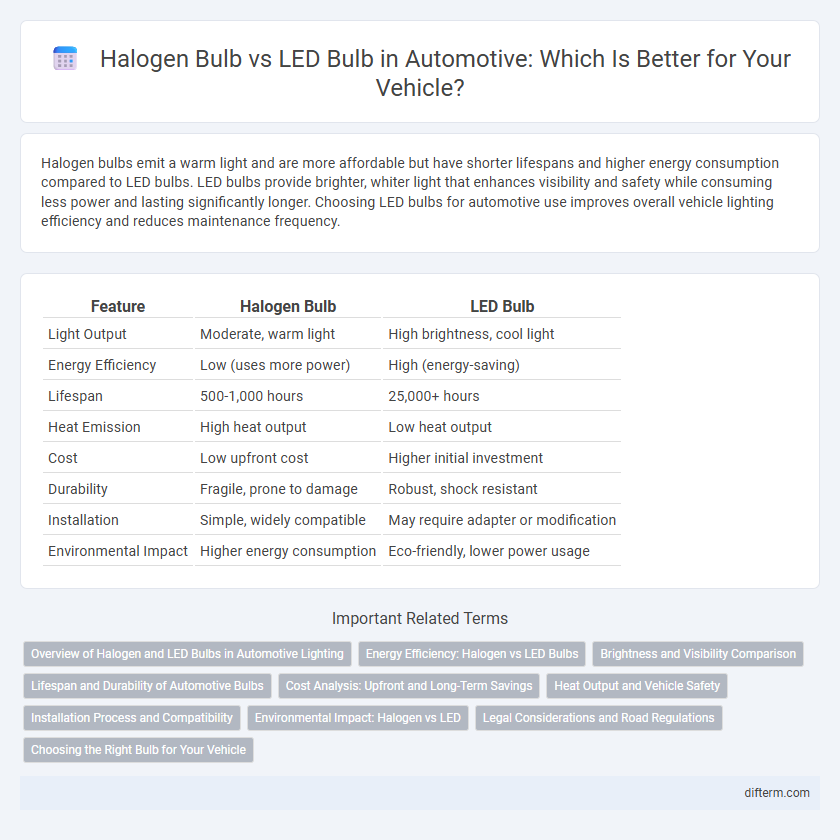Halogen bulbs emit a warm light and are more affordable but have shorter lifespans and higher energy consumption compared to LED bulbs. LED bulbs provide brighter, whiter light that enhances visibility and safety while consuming less power and lasting significantly longer. Choosing LED bulbs for automotive use improves overall vehicle lighting efficiency and reduces maintenance frequency.
Table of Comparison
| Feature | Halogen Bulb | LED Bulb |
|---|---|---|
| Light Output | Moderate, warm light | High brightness, cool light |
| Energy Efficiency | Low (uses more power) | High (energy-saving) |
| Lifespan | 500-1,000 hours | 25,000+ hours |
| Heat Emission | High heat output | Low heat output |
| Cost | Low upfront cost | Higher initial investment |
| Durability | Fragile, prone to damage | Robust, shock resistant |
| Installation | Simple, widely compatible | May require adapter or modification |
| Environmental Impact | Higher energy consumption | Eco-friendly, lower power usage |
Overview of Halogen and LED Bulbs in Automotive Lighting
Halogen bulbs in automotive lighting use a tungsten filament enclosed in a halogen gas-filled capsule, producing a warm yellowish light with moderate energy efficiency and lifespan. LED bulbs utilize semiconductor technology to emit bright, white light with higher energy efficiency, longer lifespan, and faster response times compared to halogen bulbs. The transition from halogen to LED lighting in vehicles brings enhanced visibility, reduced power consumption, and improved durability in automotive applications.
Energy Efficiency: Halogen vs LED Bulbs
LED bulbs consume up to 80% less energy than halogen bulbs, providing significant savings on power consumption in automotive lighting systems. Halogen bulbs generate more heat and convert less energy into visible light, resulting in lower overall efficiency. The higher luminous efficacy of LED technology ensures brighter illumination with reduced energy usage, enhancing fuel economy in vehicles with electrical lighting loads.
Brightness and Visibility Comparison
LED bulbs provide significantly higher brightness levels compared to halogen bulbs, emitting up to 300% more light intensity, which enhances road visibility during night driving. Halogen bulbs typically produce a yellowish light with lower lumens, around 1,000 to 1,500, whereas LED headlights can reach luminous outputs exceeding 3,000 lumens, resulting in clearer illumination of road signs and obstacles. The improved color temperature of LEDs, often around 6,000K, closely mimics daylight, reducing eye strain and improving driver reaction times in low-light conditions.
Lifespan and Durability of Automotive Bulbs
Halogen bulbs typically have a lifespan of around 450 to 1,000 hours, whereas LED bulbs can last anywhere between 15,000 to 50,000 hours, making LEDs significantly more durable for automotive lighting. LED bulbs are more resilient to vibrations and temperature fluctuations commonly experienced in vehicle environments, reducing chances of failure and maintenance costs. The superior longevity and enhanced physical robustness of LED bulbs contribute to their growing preference over halogen in modern automotive applications.
Cost Analysis: Upfront and Long-Term Savings
Halogen bulbs generally have a lower upfront cost compared to LED bulbs, making them an economical choice for immediate replacement needs. However, LED bulbs offer significant long-term savings due to their extended lifespan and reduced energy consumption, cutting maintenance and replacement expenses over time. The total cost of ownership favors LED technology, as halogen bulbs often require multiple replacements and higher power draw throughout the vehicle's lifecycle.
Heat Output and Vehicle Safety
Halogen bulbs generate significantly more heat than LED bulbs, increasing the risk of damage to surrounding components and vehicle wiring. LED bulbs operate at lower temperatures, reducing the likelihood of heat-related failures and improving overall vehicle safety. The cooler operating temperature of LEDs also minimizes fire hazards, enhancing long-term reliability in automotive lighting systems.
Installation Process and Compatibility
Halogen bulbs typically offer a straightforward installation process compatible with most standard automotive sockets, requiring no special adapters or modifications. LED bulbs may demand additional components such as resistors or CAN bus adapters to prevent flickering and error codes, making the installation slightly more complex. Compatibility varies as LEDs often require vehicles with compatible wiring and housing designed for LED heat dissipation and light projection.
Environmental Impact: Halogen vs LED
LED bulbs consume significantly less energy and have a longer lifespan compared to halogen bulbs, resulting in reduced carbon emissions and fewer replacements over time. Halogen bulbs generate more heat and use more power, contributing to higher environmental pollution during their manufacture and disposal stages. The switch from halogen to LED lighting in automotive applications supports sustainability by decreasing overall energy demand and minimizing hazardous waste.
Legal Considerations and Road Regulations
Halogen bulbs comply with most global automotive lighting regulations, including ECE and DOT standards, ensuring legal use in passenger vehicles. LED bulbs offer superior energy efficiency and longevity but must meet strict certification requirements, such as SAE J578 and ECE R112, to be road-legal. Non-compliant LED conversions can result in fines, vehicle inspection failures, and compromised road safety due to improper beam patterns or excessive brightness.
Choosing the Right Bulb for Your Vehicle
Selecting the right bulb for your vehicle involves comparing halogen and LED bulbs based on brightness, energy efficiency, and lifespan. Halogen bulbs offer affordability and easy replacement but consume more power and have a shorter lifespan compared to LED bulbs, which provide superior illumination and durability. Understanding your driving needs and vehicle compatibility ensures optimal lighting performance and safety on the road.
halogen bulb vs LED bulb Infographic

 difterm.com
difterm.com